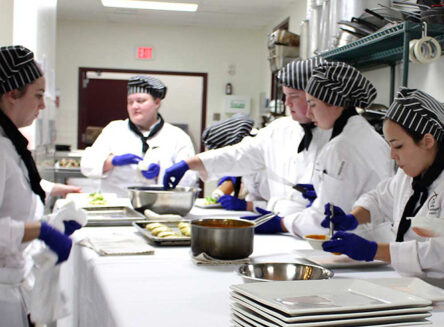
Elevated Elk Tenderloin
Born and raised in Montana, Chef Clayton McDaniel of Great Northwest Catering prefers to locally source his protein, using elk, venison, bison and beef for his clients and his family to highlight the region’s authentic flavors.
McDaniel graduated from the culinary arts and catering program at Flathead Valley Community College at age 18, where he launched his career in fine dining before decamping to work alongside chefs in in Phoenix, Arizona, mastering his skills cooking French-influenced dishes. He traveled back and forth between the Flathead and the Southwest before launching Great Northwest Catering in 2015.
Today, McDaniel continues to build on a signature style that combines French cuisine with classic Montana fare.
In his elk tenderloin recipe, for example, McDaniel uses farm-raised elk from Perfect Cuts in Columbia Falls, which he smokes with cherrywood from Bowman Cherry Orchard outside of Woods Bay. He coats the elk in an herb crust, smokes the cut of meat at a low temperature, finishes it in the oven, and tops with a huckleberry red wine sauce.
“I like to utilize local resources that we have here in Montana, whether that’s local beef or elk, to essentially just showcase and highlight the flavors we have in our backyard versus outsourcing from other parts of the world,” McDaniel said. “It’s stuff that I grew up enjoying, so I was familiar with the flavors, and I wanted to put it on a plate and use some of the French background to showcase a more Montana version.”
While McDaniel uses farm-raised elk, the process is the same with a self-harvested animal, and he says it’s important to clean off all the silver skin — the thin membrane of connective tissue found on the meat — before seasoning.
Elk typically tastes less “game-y” than venison, McDaniel says, and if his clients are apprehensive about eating protein that’s outside of their comfort zone, he introduces them to elk first.
“It’s about taking food that people in Montana are comfortable with and elevating that into a fine-dining platform … On the other side, it’s a memorable experience for people who have never had elk or venison,” he said.
But no matter what you’re cooking over the holidays, McDaniel says it’s important to add personal flair to any meal.
“Put your own spin on things, have fun and remember we are all coming together to celebrate everybody being around the dinner table,” McDaniel said. “Have fun with it and enjoy your company.”
Elk Tenderloin and Huckleberry Red Wine Sauce (serves four)
Elk
1 ½ – 2 pounds elk tenderloin
3 tablespoons chopped fresh rosemary
3 tablespoons chopped fresh thyme
2 tablespoons chopped fresh sage
5 garlic cloves, minced
Kosher salt and fresh ground black pepper to taste
2 tablespoons extra-virgin olive oil
Clean the silver skin off the tenderloin, drizzle with extra virgin olive oil and season with salt and pepper. Rub the tenderloin with minced garlic and sprinkle fresh chopped herbs to evenly coat the tenderloin.
Fill the smoker with cherrywood and preheat to 225- 250 degrees and place the tenderloin away from direct heat on the smoker. Smoke for one to one-and-a-half hours and do not exceed an internal temperature of 100 degrees.
Remove from the smoker and either cool completely or transfer directly to the oven at 350 degrees and cook to an internal temperature of 118-125 for best results.
Huckleberry Red Wine Sauce
2 cups Port wine
1/2 cup of demi-glace
1/4 cups of fresh huckleberries
1 knob of unsalted butter (1-2 tablespoons)
Simmer the huckleberries with Port wine in a saucepan and reduce the temperature by half.
Reheat the demi-glace to a slight simmer and add the demi-glace into the red wine/huckleberry mixture. Reduce the sauce temperature until it coats the back of a spoon.
Add the knob of butter and whisk until it’s incorporated.
Season to taste with salt and pepper
Pulse the wine sauce to break up the berries with an immersion blender.